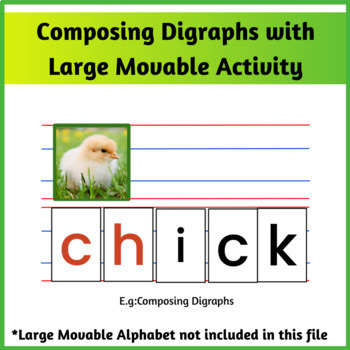Table of Contents
The first approach to non-phonetic reading is learning digraphs. If your child can compose CVC words and long phonetic words, it’s time to introduce digraphs (Montessori Green Scheme). The basic steps are almost the same as the phonetic reading.
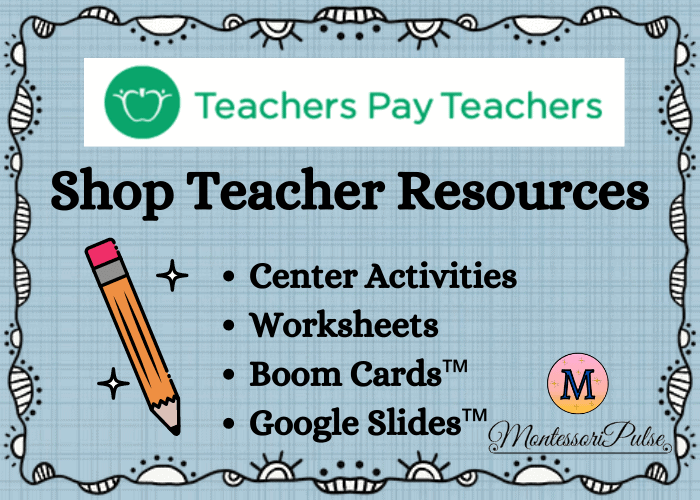
If you read my earlier blog post about Phonetic Reading you should have a clear idea about the path. But there are few important things that you need to keep in mind when it comes to digraph activities (Green Scheme).

- The words you chose must only have one digraph.
- The rest of the word should be phonetic.
- Cover all the stages for each digraph before introducing a new one.
Read “The Illustrated Guide to Montessori Phonetic Reading for Preschool”
The Montessori method uses lots of hands-on materials. But if you are not ready to invest in those, you can easily make them at home. Find out how to make your own basic materials with free printables here.
Introducing and Composing Digraphs (Green Scheme)
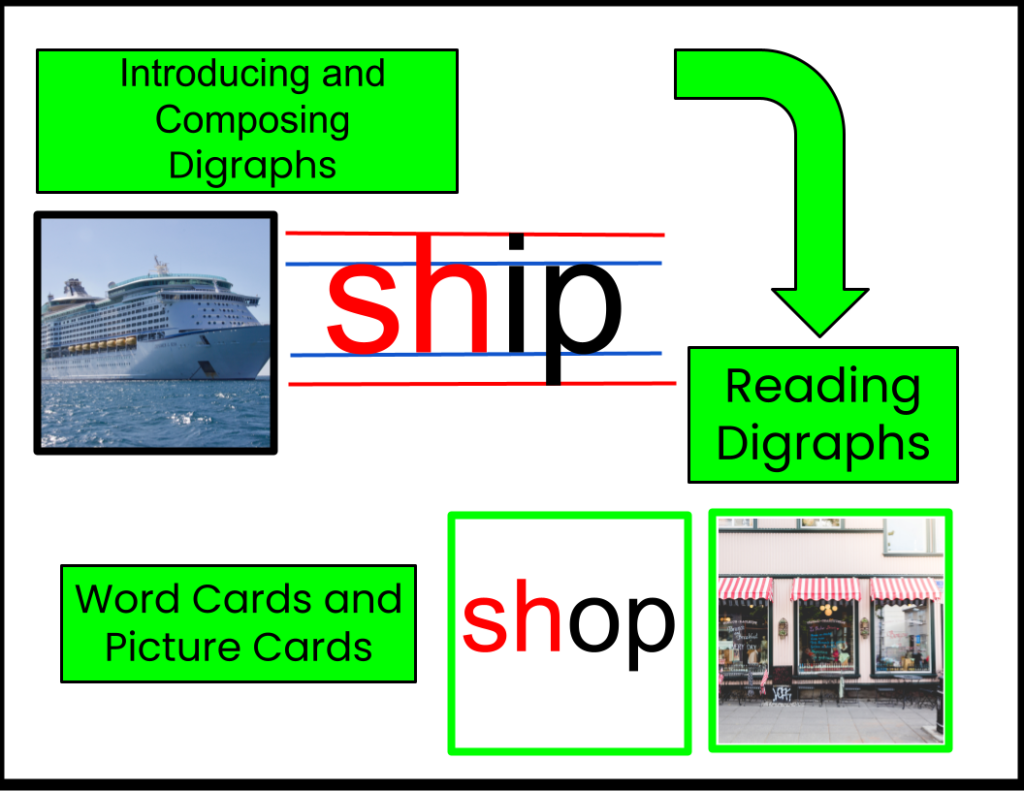
Materials: Sandpaper Digraphs and 2 Movable Alphabets in 2 Colours
The Montessori method uses Sandpaper Digraphs to introduce digraphs. But in my class, I have never used them. Depending on the child’s level you can skip that as well. Instead, you can directly start composing with the Movable Alphabet.
Composing is the exact opposite of reading. Many teachers get these two stages confused. This can have a negative effect on the child’s reading journey. At this stage, the child is not ready to read (synthesis) yet. If you give a child a reading activity at this stage, it can discourage him. The best way to clarify the difference is to give the picture first. The child looks at the picture, says what it is, and then finds the sound he hears to compose the word.
Use one colour Movable Alphabet for the digraph part and another colour for the rest of the word. When choosing words to compose, always choose words with one difficulty. E.g., if you are introducing ch, the words you use should not have other diagraphs.
Have a set of objects or picture cards of the particular digraph. E.g., ship, shop, dish…etc. As you can see, these words are phonetic except for the targetted digraph. That way it’s easy for the child to focus and learn that digraph.
Show the child how to use one colour for the digraph part and the other colour for the rest of the word.
Reading Digraphs
Reading a word is the complete opposite of composing a word. At this stage, the child should be given a word card first. He has to read and find out the picture or the object. The process is the same. Start with word cards and objects/picture cards. Make sure you have booklets, lists sentence cards and storybooks of the same digraph.
Green Word Cards and Object/Picture Cards
This is a Montessori shelf activity. Make boxes containing 6 Picture Cards and 6 Word Cards from the same digraph in each box. Keep them available on the shelf for the child to read. The child should read a word card first and find the matching picture. (This is the opposite of composing)
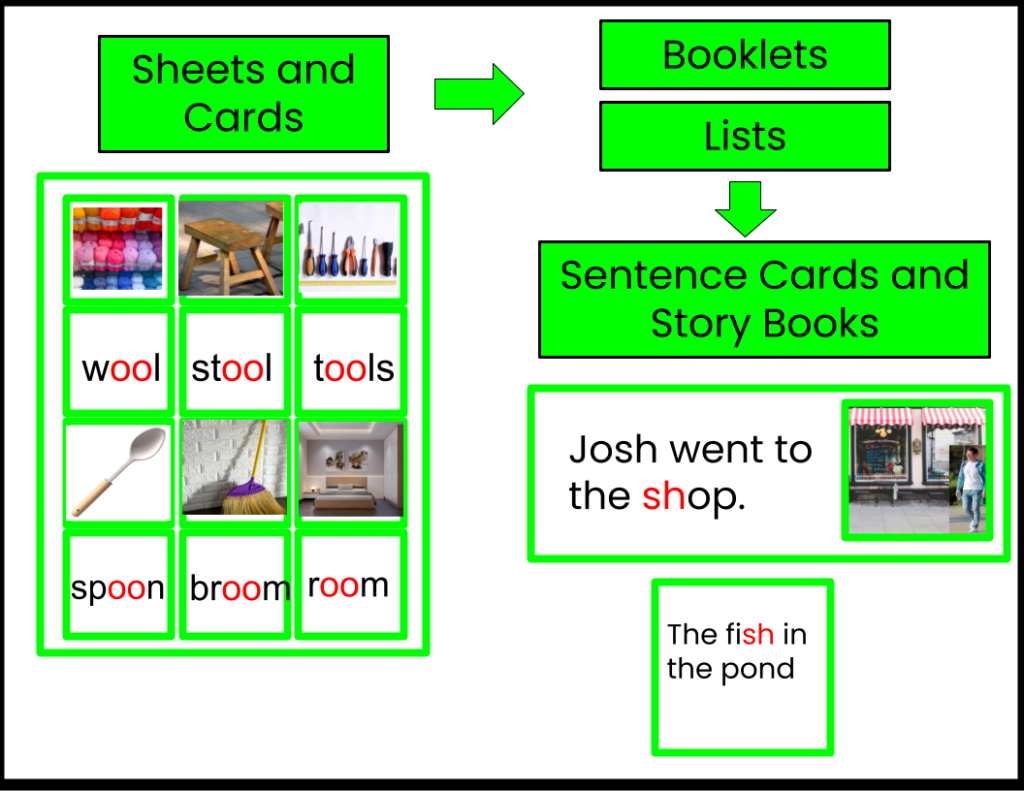
Green Sheets with Loose Word Cards
This is a shelf activity as well. The pictures are printed on sheets and the matching word cards are loose. Show the child how to read the word cards and match them with the pictures on the sheet.
Green Booklets
These are tiny booklets with only one word on each page. This is a preparation for the child to read storybooks later. There should be no pictures. The child is slowly getting used to reading words without visual aids. Because there are no pictures you can use more abstract words like shall, shut, wish…etc. Keep a few booklets on a tray and make them available on the shelf.
Green Lists
You can use abstract words for the lists as well because there are no pictures. Make a few laminated lists, keep them on a tray and make them available on the shelf.
Articles
Articles are not phonetic. The only way to learn them is to memorize them. You can introduce and review them in your circle time. Make sure to introduce both lowercase and uppercase articles. Because if they come at the beginning of a sentence, they should be uppercase.
Sight Words
Sight words are not phonetic either. they should be memorized as well. Circle time, Word Wall activities, and worksheets are ways to practice sight words. The child needs to know them at this stage to be able to read Sentences.
Once the child learns the articles and a few sight words, you can introduce Sentences. This is a good time to introduce Uppercase letters and period.
Green Sentences
Sentences come in 2 difficulty levels. Choose words with one digraph only and no other difficult words.
- Sentences with the matching picture. These are a great way to get the child familiarised with reading sentences.
- Sentences with three choices of pictures. The child should read and find the matching picture. These sentence cards are engaging and improve reading comprehension.
Green Story Books
These stories consist of 5-10 sentences of the same digraph. The rest of the words should all be phonetic except for articles and sight words.
Reading Non-phonetic Words
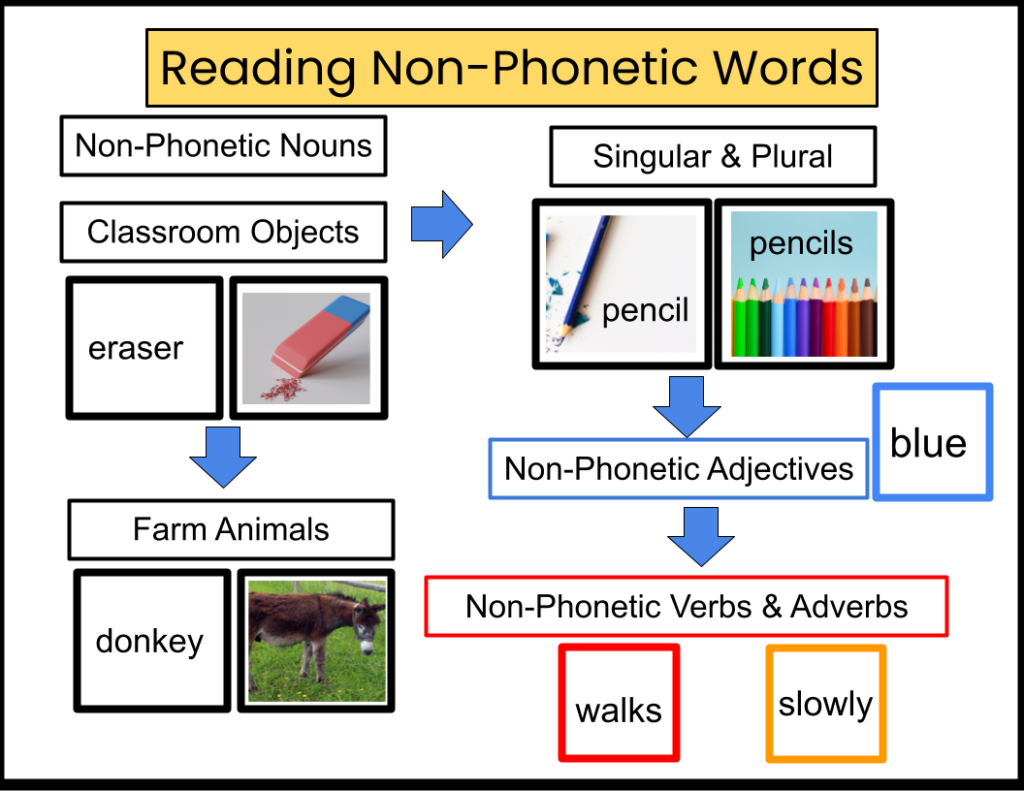
Non-Phonetic Classroom Nouns
Montessori Noun Cards are black. Have a set of non-phonetic Noun Cards. The nouns can be taken from classroom objects. At this stage, you do not have to stick to one digraph. Ask the child to read each card and keep the cards next to the object. This is an engaging activity. Because the child will be walking around the classroom looking for the objects.
Non-Phonetic Farm Nouns
After the classroom nouns, you can introduce non-phonetic Farm Nouns with Picture Cards. This is a special activity that we use to teach grammar by adding verbs, adjectives, articles…etc.
Non Phonetic Singular and Plural
Have a set of Non-phonetic Noun Cards and a set of their plurals. At this stage, you can choose nouns with -es plurals and irregular plurals as well. Show the child how to read the singular noun first and find the matching plural noun. You can even use tiny objects to show the singular/plural concept.
Non Phonetic Adjectives
Montessori Adjective Cards come in blue. This blue is a different shade than the blue scheme. To do this activity you need to have a set of Adjective Cards as well as Noun Cards to go with them. Show the child how to make a short phrase by putting a noun and an adjective together. You can put the adjective card after the noun, ask the child to read. “table blue”. Let the child fix the syntax error. When the child gets enough practice, add in verb cards. Try to get the child’s attention to the word order.
Non-Phonetic Verbs and Adverbs
Montessori Verb Cards are red. Have a set of non-phonetic Verb Cards. Ask the child to read and do the verb. Match with farm animal nouns to make a short phrase. E.g., The donkey sleeps. When the child is familiar with the verbs introduce adverbs. Let the child read and figure out the correct position. E.g., The cow walks slowly.
Conclusion
Montessori Digraphs and non-phonetic reading have few stages. This illustrated guide will help you find out your child’s level, so you can continue from there. This is a rough guide and outline to get an idea of the sequence you should follow. After all these stages the child can slowly move on to any storybook. Keep some level 1 book available for the child to read.
All the resources for these activities will soon be added to my Teachers Pay Teachers store.

